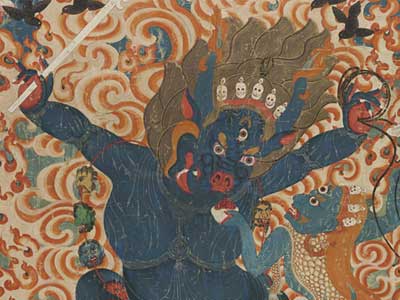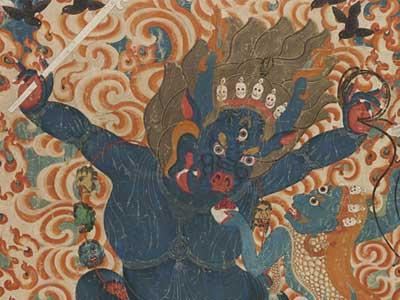On December 7 one of our masterpieces will be going into storage—Yama and Yami, an eight-foot-tall Tibetan ceremonial painting (or thangka) from the late seventeenth or early eighteenth century. If you're coming to the museum this week, make a point to come up to the Ahmanson Building's fourth floor to check it out (you'll pass it on your way to the Five Centuries of Indonesian Textiles exhibition).

Eastern Tibet, Kham region, Himalayas, Yama and Yami (detail), c. 1675-1725
It is a vivid and viscerally affecting painting. Yama, the Lord of the Underworld and judger of souls, dances violently with his sister, Yami, atop a blue bull, which makes itself at home upon a nude woman—it's basically the most frightening dogpile you might ever imagine. Yama, who has three eyes and the head of a buffalo, holds a staff in one hand and a noose in the other, and is surrounded by a wall of flames (note, however, the apparently heat-resistant birds fluttering around his head). He wears a crown of skulls and a necklace of severed heads, while Yami, similarly adorned, offers him a cup of "demon-blood elixir." Adding to the vibrant lunacy of the painting are more severed heads, flowers, clouds, water, and five miniature versions of Yama—in blue, red, white, and orange—placed in the corners and apex of the painting. I can't believe we omitted this painting from our Halloween post on creepy works in the museum; it's definitely right up there.
The painting is chock-full of imagery—more than I can describe nor even understand, especially in the space of this blog post. Happily, you can take an online tour of the painting's meaning, as well as read the fascinating behind-the-scenes story of the long conservation process that restored Yama and Yami to all its terrifying glory. It's a more than worthy read, before or after you take a look at the painting in person.



